We may not have the course you’re looking for. If you enquire or give us a call on +44 1344 203 999 and speak to our training experts, we may still be able to help with your training requirements.
Training Outcomes Within Your Budget!
We ensure quality, budget-alignment, and timely delivery by our expert instructors.
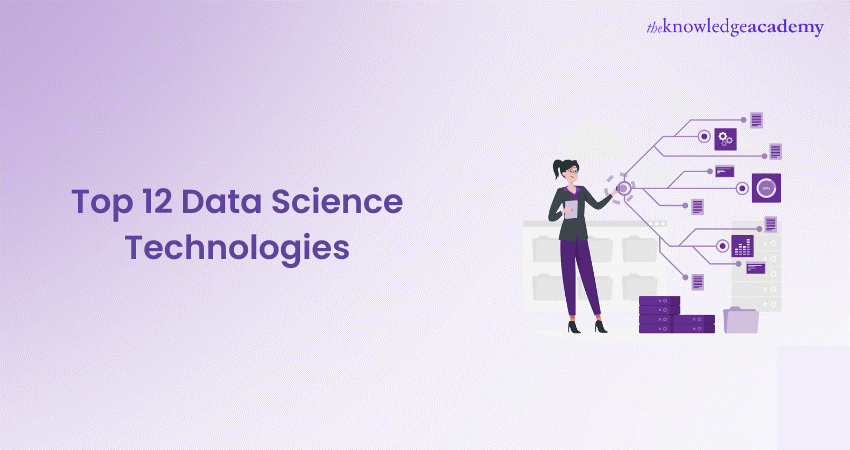
Data Science Technologies have become a powerful force to reckon with, being the very backbone of modern decision-making, innovation, and competitiveness. These technologies are the linchpin connecting raw information to actionable insights.
According to a 2022 report by Snowflake, Data Scientists noticed a 35 per cent decrease in the time consumed to complete data operations because of Automated Machine Learning or AutoML support. This statistic demonstrates how Data Science Technologies are instrumental in extracting knowledge from vast and complex data sets to make informed decisions, predict future trends, and optimise their operations. Dive into the world of Data Science Technologies and discover the essential tools and platforms used for Data Analysis and Analytics.
Table of Contents
1) A brief overview of Data Science Technologies
2) Exploring the Top 12 Data Science Technologies
a) Amazon Web Services or AWS
b) Amazon Redshift
c) Amazon Simple Storage Service or S3
d) Text Mining
e) Streaming analytics
f) Machine Learning
g) Decision intelligence
h) Automatic Predictive Service
I) Edge computing
j) Quantum computing
k) Augmented and Virtual Reality systems
l) Python and Pandas
3) Conclusion
A brief overview of Data Science Technologies
Data Science is a multidisciplinary field that blends the fields of Statistics, Computer Science, and domain knowledge. It has transformed how you can extract insights from vast data sets, making informed decisions and predictions. The rapid evolution of Data Science technologies has significantly enhanced users' ability to harness the full potential of data.
Additionally, Machine Learning and Deep Learning have taken centre stage in the Data Science arena. These technologies help computers to learn and make predictions from data without explicit programming. Natural Language Processing,or NLP has revolutionised how we interact with and understand human language, from chatbots to language translation.
Now, handling vast amounts of data is a fundamental challenge for organisations, and Big Data technologies such as Hadoop and Spark have become essential for data storage, processing, and analysis. Data visualisation and Business Intelligence tools, like Tableau and Power BI, help organisations transform complex data into actionable insights through interactive graphs and dashboards.

Exploring the Top 12 Data Science Technologies
Data Science Technologies are pivotal in the modern market because they are built to empower organisations, so they are able to extract insights from data, make data-driven decisions, optimise operations, and create innovative products and services.
From Machine Learning to Big Data Tools, these technologies enable businesses to stay competitive, improve customer experiences, and drive growth. Here is a list curating the Top 12 Data Science Technologies in the market:
Amazon Web Services or AWS
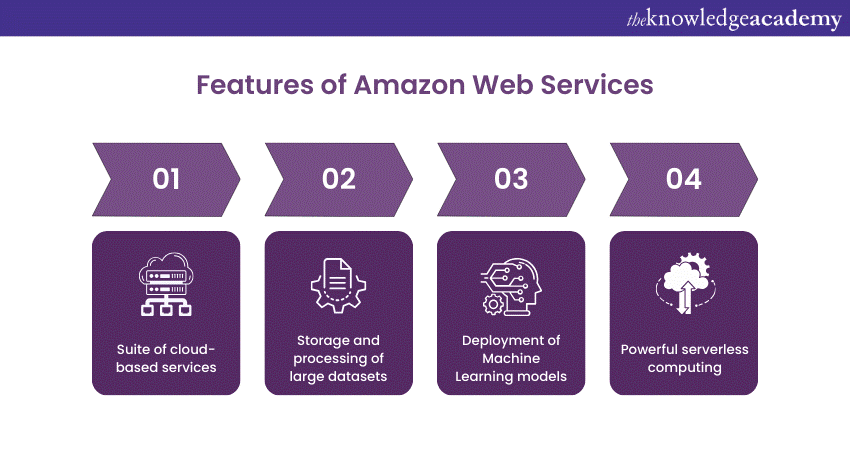
Amazon Web Services, or AWS, is undeniably one of the most exceptional Data Science Technologies available. AWS offers users a comprehensive suite of cloud-based services that provide the necessary infrastructure, tools, and resources for Data Scientists to carry out their work effectively.
Additionally, AWS is designed to help Data Scientists store and process large datasets, deploy Machine Learning models, and conduct complex analytics tasks at scale. Services like Amazon SageMaker simplify the Machine Learning lifecycle, from model development to deployment, while AWS Glue streamlines data preparation and integration.
The extensive choice of EC2 instance types, S3 storage, and managed databases ensures the flexibility and scalability required for data-intensive projects. Moreover, AWS also offers powerful serverless computing through Lambda, data warehousing with Amazon Redshift, and numerous AI and analytics tools such as Amazon Comprehend and QuickSight.
Its global reach, reliability, and security standards make AWS a go-to choice for businesses across industries seeking to leverage data science to gain a competitive edge. AWS ultimately empowers Data Scientists to harness the full potential of their data, making it a cornerstone in the realm of Data Science Technologies.
Harness the complete potential of Cloud Computing by signing up for our AWS Cloud Practitioner Training now!
Amazon Redshift
Amazon Redshift is undeniably one of the best Data Science technologies, particularly in the realm of data warehousing and analytics. Redshift, offered as part of Amazon Web Services (AWS), is a fully managed, petabyte-scale data warehousing solution designed to handle vast amounts of data and deliver rapid query performance.
Additionally, Amazon Redshift’s outstanding columnar storage architecture optimises data retrieval and analytical processing. It efficiently handles complex queries, making it a powerful tool for Data Scientists looking to extract meaningful insights from large datasets. Redshift also supports various data formats, including JSON and Avro, ensuring flexibility in data integration.
Furthermore, Redshift offers seamless scalability, allowing its users to adjust their data warehouse capacity based on their needs. Its integration with other AWS services, such as S3, allows Data Scientists to build robust, end-to-end data pipelines.
The security features, compliance certifications, and cost-effectiveness of Amazon Redshift further solidify its position as a top data science technology. Data scientists rely on Redshift for its ability to transform raw data into actionable insights, making it an invaluable asset in the world of Data Analytics and decision-making.
Learn about Data warehousing and distribution by signing up for our Amazon Redshift Training now!
Amazon Simple Storage Service or S3
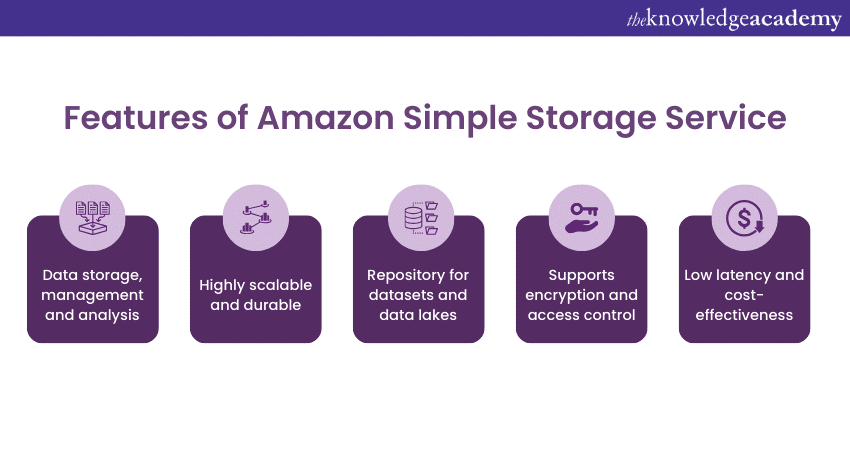
Amazon Simple Storage Service, or Amazon S3, is undoubtedly one of the most essential and versatile Data Science Technologies available. It plays a pivotal role in data storage, management, and analysis for businesses and data scientists worldwide.
Additionally, Amazon S3 is a highly scalable and durable object storage service that allows data scientists to store and retrieve data of all sizes securely. Its user-friendly functionality and flexibility make it an indispensable tool in data science workflows. S3 is the perfect repository for large datasets, data lakes, and model training data, considering its vast storage capacity and ability to handle structured and unstructured data,
What makes Amazon S3 stand out is its integration with other AWS services and its compatibility with a wide range of data science tools and libraries. It supports data versioning, access control, and encryption, ensuring the security of data and compliance with regulatory requirements.
Moreover, as data is the lifeblood of Data Science, Amazon S3's reliability, low latency, and cost-effectiveness make it a top choice for data scientists, allowing them to focus on analysis and innovation rather than data storage concerns. Amazon S3 is basically a cornerstone of modern Data Science, offering the scalability, accessibility, and durability required to work with diverse and ever-expanding datasets.
Manage documents and data models by signing up for our Amazon S3 Glacier Training now!
Text mining
Text mining, often referred to as Natural Language Processing or NLP, is one of the many impactful Data Science technologies. It involves the automated extraction of valuable information from unstructured text data, enabling organisations to derive insights from a vast array of textual sources, including documents, social media, and customer feedback.
Additionally, Text mining is instrumental in sentiment analysis, topic modelling, and information retrieval. It allows businesses to understand customer opinions, detect emerging trends, and improve decision-making processes.
NLP technologies like Bidirectional Encoder Representations from Transformers or BERT and Generative Pre-trained Transformer or GPT-3 have pushed the boundaries of what's possible in understanding and generating human-like text.
Furthermore, Data Scientists leverage text mining to gain a deeper understanding of customer behaviours, automate content categorisation, and extract key information from massive document archives. This technology has applications in various industries, including marketing, healthcare, finance, and e-commerce.
The ability to analyse and derive insights from text data is crucial in an information-rich world, making text mining one of the most invaluable Data Science technologies, driving innovation, and competitive advantage.
Learn to extract meaningful information by signing up for our Text Mining Training now!
Streaming analytics
Streaming analytics is among the most dynamic and transformative data science technologies in the market. It involves real-time data processing and analysis of data streams as they are generated, enabling organisations to make instant decisions, detect anomalies, and gain insights from live data sources.
Additionally, Streaming analytics is crucial for industries that require immediate action, such as finance (fraud detection), healthcare (patient monitoring), and IoT (sensor data). Tools like Apache Kafka and Apache Flink allow data scientists to ingest, process, and analyse data in motion, offering real-time insights.
Moreover, the importance of streaming analytics extends to personalisation in e-commerce, predictive maintenance in manufacturing, and improving user experiences in applications. It empowers data scientists to apply machine learning models and complex algorithms on-the-fly, resulting in improved decision-making, better customer experiences, and improved operational efficiency.
Machine Learning
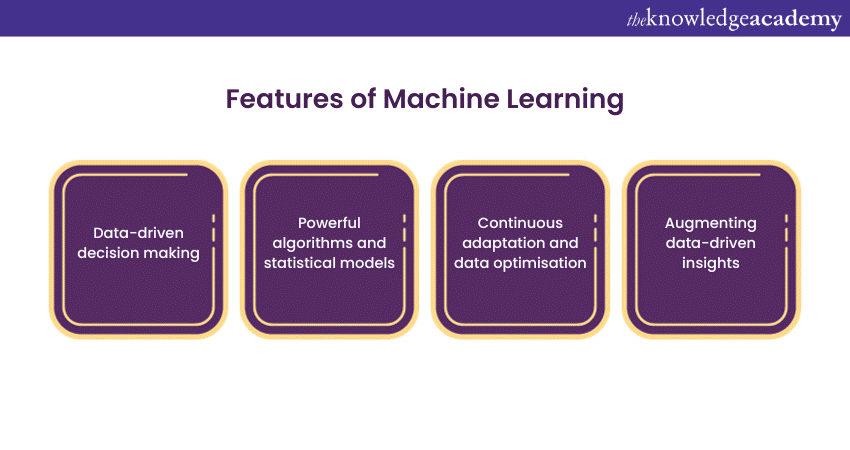
Machine Learning is undoubtedly one of the most pivotal and influential Data Science technologies of our time. It represents the core of data-driven decision-making, enabling computers to learn from data and make predictions or automate tasks without explicit programming.
Additionally, Machine Learning applications span across countless domains, from recommendation systems in E-commerce to predictive maintenance in Manufacturing. It empowers Data Scientists to harness the power of algorithms and statistical models for anomaly detection, image and speech recognition, natural language processing, and much more.
Furthermore, one of the strengths of Machine Learning is its ability to continuously adapt and improve over time as more data becomes available. With the onset of deep learning, Machine Learning has achieved remarkable success in tasks that were previously considered highly challenging, such as autonomous driving and complex image analysis.
Moreover, Machine Learning is not only transforming industries but also augmenting human decision-making with data-driven insights. As businesses become increasingly reliant on data to stay competitive, Machine Learning remains at the forefront of Data Science Technologies, offering limitless possibilities for innovation and growth.
Attain mastery of neural networks, algorithms and more by signing up for our Machine Learning Training now!
Decision Intelligence
Decision Intelligence, or DI, is emerging as one of the most innovative and impactful Data Science Technologies. It represents a significant advancement in the Data Science field by combining Data Analytics, Artificial Intelligence, and Decision Theory to optimise and automate complex decision-making processes.
Additionally, DI goes beyond traditional data analytics by focusing on the actions and decisions that result from data insights. It considers not only data-driven predictions but also the trade-offs, uncertainties, and ethical considerations that play a vital role in making decisions.
By integrating Machine Learning, optimisation, and prescriptive analytics, DI enables organisations to make more informed and efficient decisions in various domains, including supply chain management, finance, healthcare, and customer service. It assists in resource allocation, risk management, and process optimisation.
Moreover, DI is particularly relevant in an era of big data and increasing complexity, as it helps organisations extract actionable insights from vast datasets, resulting in improved operational efficiency, cost reduction, and enhanced customer experiences.
It is an evolving field that holds the promise of driving smarter, more strategic, and ethically sound decision-making, making it one of the best Data Science technologies for modern businesses.
Automatic Predictive Service
Automatic Predictive Service, also known as AutoML or Automated Machine Learning, is one of the most valuable Data Science Technologies that streamlines and simplifies the process of building predictive models. It is well-known due to its ability to democratise Data Science and make predictive analytics accessible to a wider range of professionals.
Additionally, AutoML platforms like Google AutoML, DataRobot, and H2O.ai provide automated tools and workflows that significantly reduce the time and expertise required to develop accurate predictive models.
This technology mainly leverages Machine Learning to automatically select the best algorithms, preprocess data, and tune hyperparameters, allowing users to focus on the business problems they want to solve rather than the intricacies of model building.
Moreover, Automatic Predictive Service is invaluable for organisations that have limited data science resources or those seeking to rapidly deploy predictive analytics solutions. It enables faster decision-making, enhances business insights, and promotes data-driven strategies, making it a powerful asset in the data science toolkit and an excellent option for businesses looking to leverage data for competitive advantage.
Edge computing
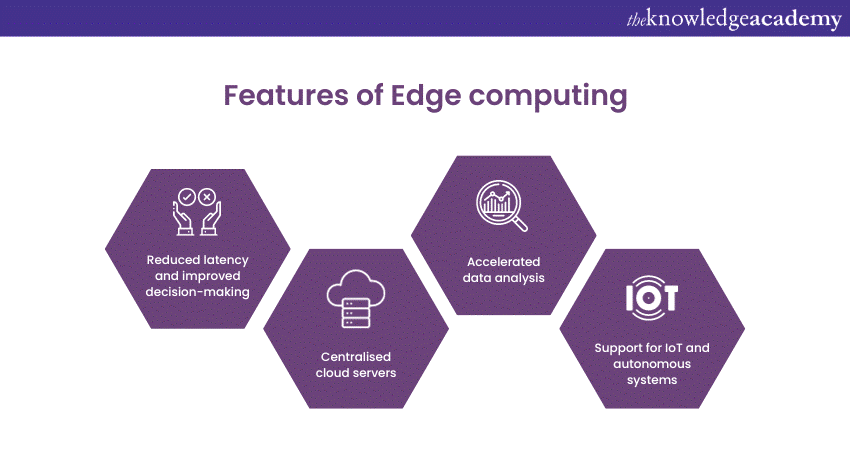
Edge computing is a cutting-edge Data Science technology that's gaining prominence due to its ability to process data in closer proximity to its source, reducing latency and enhancing real-time decision-making. By shifting computational tasks from centralised cloud servers to the network’s ‘edge’, edge computing accelerates data analysis and supports applications like IoT devices and autonomous systems.
More importantly, it enables faster response times, critical in sectors such as healthcare, manufacturing, and autonomous vehicles. Edge computing empowers data scientists to derive insights in real-time, unlocking new possibilities for data-driven innovation while optimising network resources and ensuring privacy and security.
Quantum computing
Quantum computing is well-known as an avant-garde Data Science technology holding tremendous potential in revolutionising Data Analysis and Problem-Solving. By leveraging the principles of quantum mechanics, it processes information in a radically different way than classical computers.
Quantum computers can perform complex calculations, such as optimisation and simulations, at unprecedented speeds, making them ideal for data-intensive tasks in fields like Cryptography, Materials Science, and Pharmaceuticals.
Moreover, Data Scientists anticipate that Quantum Computing will significantly accelerate data analysis, unlocking new possibilities for data-driven insights and tackling previously intractable problems.
Learn about classical and quantum circuits by signing up for our Quantum Computing Training now!
Augmented and Virtual Reality systems
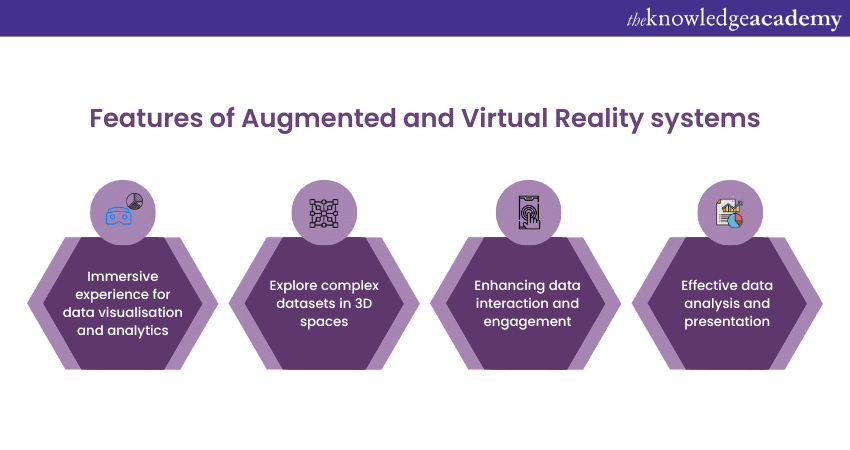
Augmented and Virtual Reality or AR/VR systems are emerging as powerful Data Science Technologies, transforming the way we interact with data. These technologies merge the physical and digital worlds, offering immersive experiences for data visualisation and analytics.
Additionally, Data Scientists can use AR/VR to explore complex datasets in three-dimensional space, making data patterns more apparent and facilitating data-driven decision-making. These technologies also have applications in training, simulations, and telemedicine.
Moreover, by enhancing data interaction and engagement, AR/VR systems are contributing to more effective data analysis and presentation, making them valuable tools for data scientists seeking innovative ways to extract insights and communicate data-driven findings.
Acquire an understanding of rendering virtual worlds by signing up for our Virtual Reality (VR) Training now!
Python and Pandas
Python and Pandas are among the most vital Data Science Technologies, offering a versatile and efficient ecosystem for data manipulation and analysis. Python, with its simplicity and extensive libraries, serves as a go-to language for Data Science tasks.
Furthermore, Pandas is designed as a powerful data manipulation library, simplifies data handling, allowing Data Scientists to clean, transform, and explore data with ease. This dynamic duo enables seamless integration with other data science libraries like NumPy, SciPy, and scikit-learn.
Moreover, Python and Pandas empower Data Scientists to process and analyse data efficiently, making them essential tools for conducting data-driven research, generating insights, and building machine learning models.
Combine your programming skills, statistics and domain knowledge by signing up for our Data Science Training now!
Conclusion
We hope that you have understood how Data Science Technologies continue to redefine industries and shape the data-driven future. From Machine Learning to Augmented Reality, these tools empower Data Scientists to unlock valuable insights and drive innovation across various domains. Staying informed and adapting to these technologies are the keys to leveraging the full potential of Data Science Technologies.
Learn to deploy Python for Data Science by signing up for our Python Data Science Training now!
Frequently Asked Questions
Upcoming Data, Analytics & AI Resources Batches & Dates
Date
 Amazon Redshift Training
Amazon Redshift Training
Fri 24th Jan 2025
Fri 21st Mar 2025
Fri 2nd May 2025
Fri 27th Jun 2025
Fri 29th Aug 2025
Fri 3rd Oct 2025
Fri 5th Dec 2025







 Top Rated Course
Top Rated Course


 If you wish to make any changes to your course, please
If you wish to make any changes to your course, please


